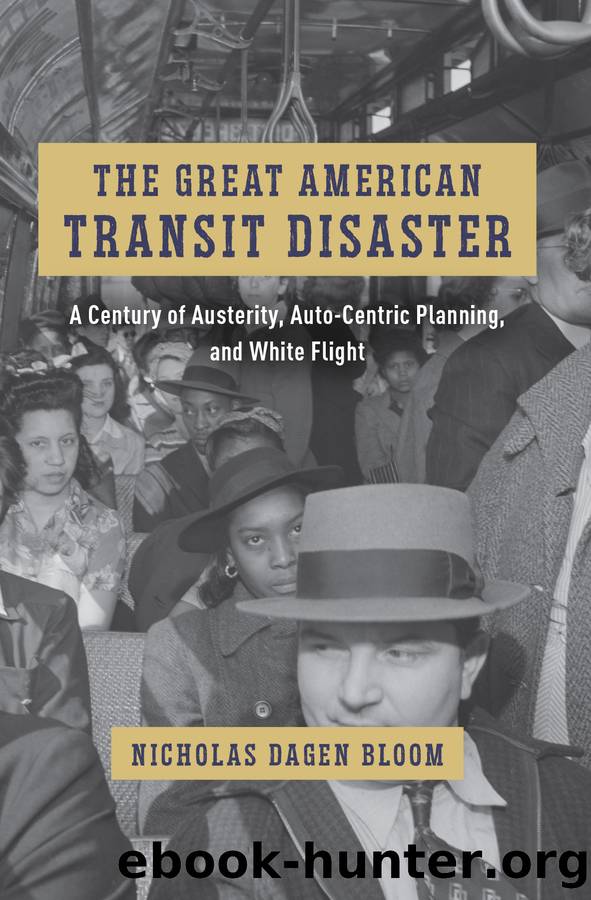The Great American Transit Disaster by Nicholas Dagen Bloom

Author:Nicholas Dagen Bloom [Bloom, Nicholas Dagen]
Language: eng
Format: epub
Tags: HIS000000 HISTORY / General, HIS036060 HISTORY / United States / 20th Century, TRA009000 TRANSPORTATION / Public Transportation, POL002000 POLITICAL SCIENCE / Public Policy / City Planning & Urban Development
Publisher: University of Chicago Press
Published: 2023-05-03T00:00:00+00:00
Figures 19a and 19b. Latino immigrants were crucial to sustained CTA ridership in areas well served by transit on the Near West and North Sides (upper map). But the decentralization of the Latino population to areas barely served by transit threatens to undermine their ridership levels (lower map). Source: Hispanic or Latino, 1970/2020, Social Explorer, accessed June 26, 2021.
CTA has had some modest successes in the last few decades, such as the elevated southwest Orange Line (1997) to Midway airport, renovated rapid stations, new buses, and has expanded bus signal priority.235 However, transitâs overall share of city commuters between 1980 and 2018 sank from 32.4 to 26.1 percent, while city automobile commuters increased from 58.5 to 65.4 percent in the same period.236 CTA has a limited ability to address these trend lines. Its mandatory high farebox recovery rate diverts most revenue to basic operations. In 2019, for instance, its rail farebox recovery of 49.6 percent was high compared to most peer agencies nationally. CTA is also dangerously underfunded on the capital side, with an estimated $18.9 billion in capital need. A considerable number of rail cars, for instance, have been kept in service beyond their projected lifespans. Complaints on both the bus and rail lines are up.237
The launching of the CTA in 1946 on a âpay as you goâ model was widely praised at the time by fiscally conservative leaders. Yet CTAâs self-supporting model, even with efficiencies from streetcar substitution, was unsustainable in an auto-centric, racially divided, and low-density region. Ridership fell but ultimately stabilized on modern elevated lines, but decades of fare increases and service cuts on the more comprehensive bus system accelerated ridership decline. Chicago demonstrated that American transit would fail to compete with cars absent deep subsidies.
The crucial role of density in transit operations also comes through powerfully in Chicagoâs story. The dispersed pattern of suburban living, where most Chicagoland residents, rich or poor, live today, makes it exceedingly difficult to provide transit outside the central city. In 2018, for instance, just 20 percent of regular commuters in the Chicago region living below the poverty line chose transit. If this growing working class in the suburbs lived and worked in suburban places better served and designed for transit efficiency, a large population might want to spend less on their automobiles.238
Chicagoâs transit history also points to the necessity of balancing transit and highway planning. Chicago was a leader in developing the countryâs first highway median rapid lines, but the experiment faltered thanks to lack of funding and suburban cooperation. CTA lost ridership for many reasons, but primarily because driving became a better option. City and state leaders who created an excellent highway network, lots of CBD parking, and widened streets knew exactly what they were doing.
Download
This site does not store any files on its server. We only index and link to content provided by other sites. Please contact the content providers to delete copyright contents if any and email us, we'll remove relevant links or contents immediately.
| Automotive | Aviation |
| History | Mass Transit |
| Owner's Manuals & Maintenance Guides | Railroads |
| Reference | Ships |
Small Unmanned Fixed-wing Aircraft Design by Andrew J. Keane Andras Sobester James P. Scanlan & András Sóbester & James P. Scanlan(32743)
Navigation and Map Reading by K Andrew(5111)
Endurance: Shackleton's Incredible Voyage by Alfred Lansing(4676)
And the Band Played On by Randy Shilts(2129)
Wild Ride by Adam Lashinsky(1933)
Top 10 Prague (EYEWITNESS TOP 10 TRAVEL GUIDES) by DK(1930)
The Box by Marc Levinson(1930)
The Race for Hitler's X-Planes: Britain's 1945 Mission to Capture Secret Luftwaffe Technology by John Christopher(1817)
The One Percenter Encyclopedia by Bill Hayes(1787)
Trans-Siberian Railway by Lonely Planet(1703)
Girls Auto Clinic Glove Box Guide by Patrice Banks(1684)
Bligh by Rob Mundle(1653)
Looking for a Ship by John McPhee(1630)
Batavia's Graveyard by Mike Dash(1607)
Good with Words by Patrick Barry(1602)
TWA 800 by Jack Cashill(1592)
Fighting Hitler's Jets: The Extraordinary Story of the American Airmen Who Beat the Luftwaffe and Defeated Nazi Germany by Robert F. Dorr(1591)
Troubleshooting and Repair of Diesel Engines by Paul Dempsey(1557)
Ticket to Ride by Tom Chesshyre(1543)
